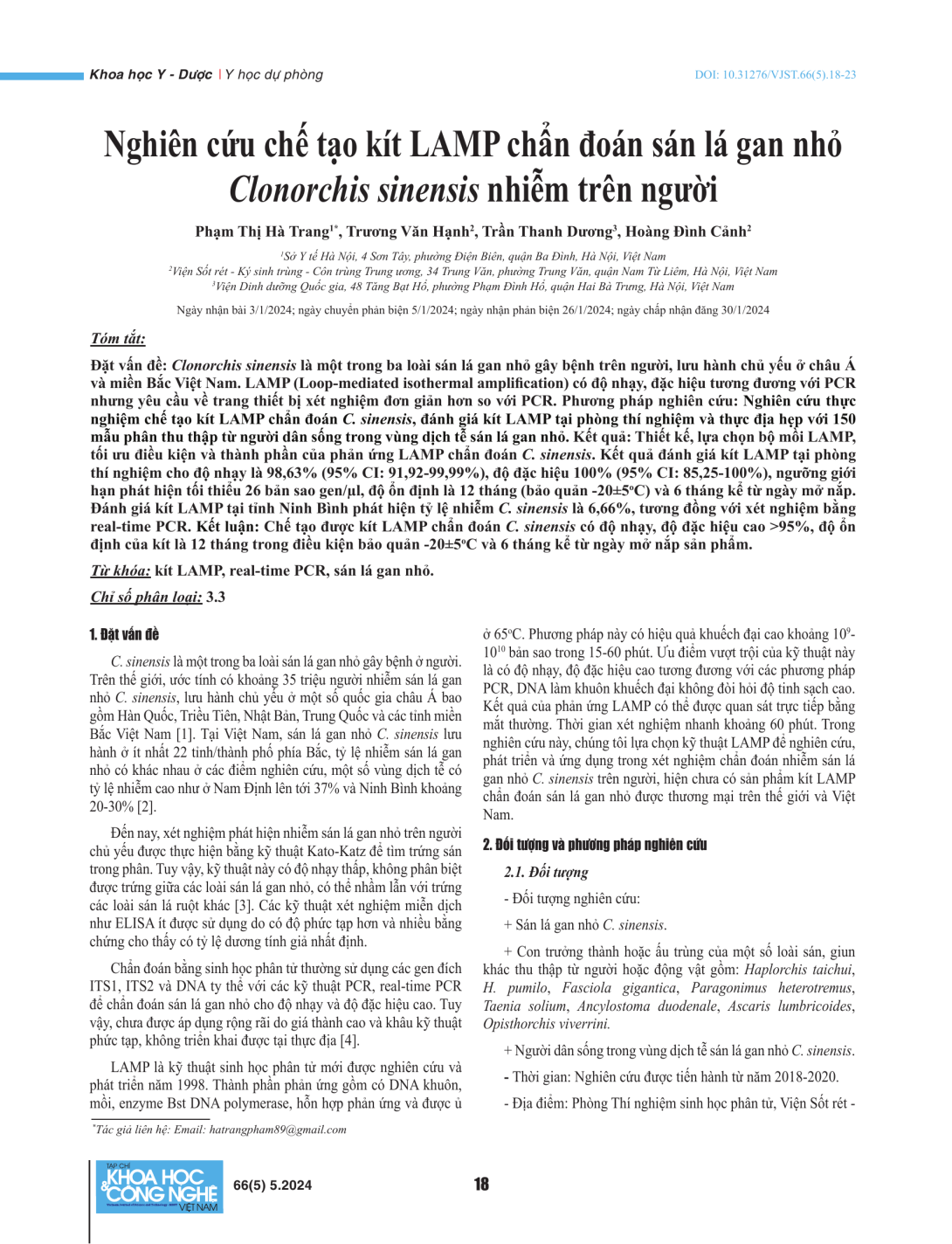
Clonorchis sinensis là một trong ba loài sán lá gan nhỏ gây bệnh trên người, lưu hành chủ yếu ở châu Á và miền Bắc Việt Nam. LAMP (Loop-mediated isothermal amplification) có độ nhạy, đặc hiệu tương đương với PCR nhưng yêu cầu về trang thiết bị xét nghiệm đơn giản hơn so với PCR. Phương pháp nghiên cứu: Nghiên cứu thực nghiệm chế tạo kít LAMP chẩn đoán C. sinensis, đánh giá kít LAMP tại phòng thí nghiệm và thực địa hẹp với 150 mẫu phân thu thập từ người dân sống trong vùng dịch tễ sán lá gan nhỏ. Kết quả: Thiết kế, lựa chọn bộ mồi LAMP, tối ưu điều kiện và thành phần của phản ứng LAMP chẩn đoán C. sinensis. Kết quả đánh giá kít LAMP tại phòng thí nghiệm cho độ nhạy là 98,63% (95% CI: 91,92-99,99%), độ đặc hiệu 100% (95% CI: 85,25-100%), ngưỡng giới hạn phát hiện tối thiểu 26 bản sao gen/μl, độ ổn định là 12 tháng (bảo quản -20±5oC) và 6 tháng kể từ ngày mở nắp. Đánh giá kít LAMP tại tỉnh Ninh Bình phát hiện tỷ lệ nhiễm C. sinensis là 6,66%, tương đồng với xét nghiệm bằng real-time PCR. Kết luận: Chế tạo được kít LAMP chẩn đoán C. sinensis có độ nhạy, độ đặc hiệu cao >95%, độ ổn định của kít là 12 tháng trong điều kiện bảo quản -20±5oC và 6 tháng kể từ ngày mở nắp sản phẩm.
Clonorchis sinensis is one of the three species of small liver flukes that cause infections in humans. C. sinensis is found mainly in several Asian countries and Northern, Vietnam. The Loop-mediated isothermal amplification (LAMP) with a sensitivity and specificity comparable to that of the PCR method, which requires less complex equipment and facilities for performance. Methods: The research design describes the laboratory experiment and evaluates a LAMP kit for the diagnosis of C. sinensis in the laboratory and the small-scale field assessment, using 150 human stool samples from fascioliasis endemic areas. Results: The LAMP primer sets have been designed and selected; the conditions and components of the LAMP reaction for C. sinensis diagnosis have been optimised. Evaluation results of the LAMP kit in the laboratory showed a sensitivity of the test was 98.63% (95% CI: 91.92-99.99%); a specificity was 100% (95% CI: 85.25-100%); the limit of detection was 26 gene copies/μl. The LAMP test kit was found to be stable within 12 months at -20±5oC, and 6 months after opening the tubes. The field assessment of the LAMP kit in Ninh Binh province showed a C. sinensis rate of 6.66%, which was similar to the rate obtained from the studies using the real-time PCR method. Conclusions: The research has successfully produced a LAMP kit for the diagnosis of C. sinensis that is sensitive >95% and highly specific >95%. The LAMP kit is stable within 12 months at -20±5oC and for 6 months after opening the tubes.
- Đăng nhập để gửi ý kiến
